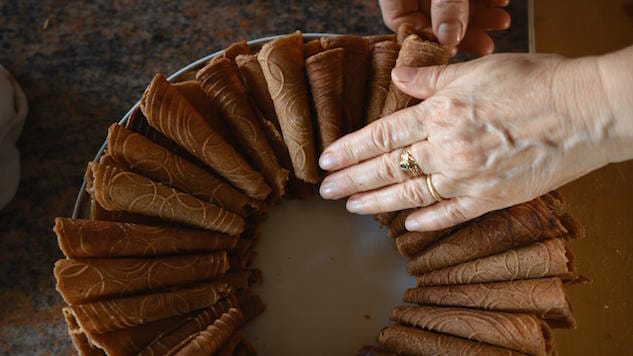
Ask a random group of Americans about their favorite Italian cookies and their responses, though sincere and ardent, will likely begin to blend into one universal chorus of: “Rainbow cookies…those colored, layered cookies — You know, those cookies that look like an Italian flag…wait, do Zeppoles count?” (For the record, no, they do not count).
Italy is made up of 20 distinctive regions. Within each region, there are countless provinces, smaller cities, and villages that are as I write this, producing some of the most delicious and authentically Italian cookies that often times rarely make it out of their province, never mind all the way across the Atlantic and onto the shelves of a bakery in Akron, Ohio.
“A lot of the cookies you find in Italian bakeries actually have no Italian roots,” says chef and cookbook author Allison Robicelli. “Italian cookies can be very expensive to produce. Most of the traditional recipes I’ve discovered contain nuts and/or citrus, which was plentiful in the old country. Not so here. Most Italian bakeries don’t make their own cookies. They’re manufactured by giant factories, bought at wholesale, and resold. That’s what keeps the price down.”
These 10 Italian cookies are the pride of their region — and some are such obscure treasures they are hardly known outside of the small towns and villages that gave them life.
1. Le Nevole — Ortona, Abruzzo
The main ingredient in Ortona’s citrusy, sultry-tasting Nevole is mosto cotto, unfiltered grape juice that locals make using Montepulciano grapes picked only in September and October (you can use other table grapes but the taste of your cookies will change dramatically). Adding to its exclusivity is the fact that the iron used to create le Nevole’s unique design is only manufactured in one place: a town 30 miles from Ortona called La Guarda Grele. The cookies are sold in shops all over Ortona, a municipality of Chieti, but travel a few miles in any direction and you may find locals who have never heard of them. And yet, these are arguably the most significant cookies in this part of Abruzzo. “After the war, there was so much poverty and hunger here and this was the only dessert that required just a few ingredients,” says Mariapia Zucaro, a baker from San Leonardo, Ortona. “The first time I made them I burned my fingers. After some time, they got easier to make — and they’re so good.”
2. Ossi Dei Morti Biscotti — Piedmont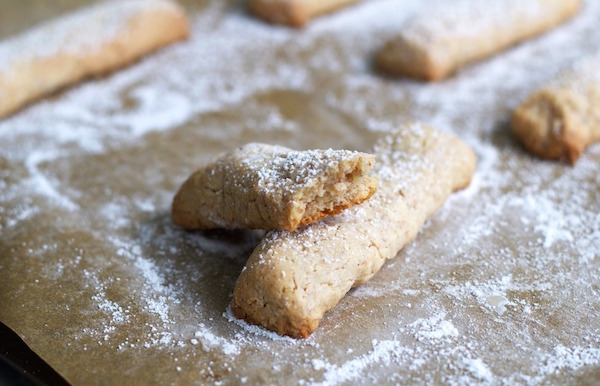 Photo by Tom Mancuso
Photo by Tom Mancuso
Leave it to the Italians to commemorate the dead on All Soul’s Day through culinary masterpieces like Ossi Dei Morti, which literally means “bones of the dead” and are shaped to resemble bones. The key ingredients in this seasonal recipe are sweet almond flour and ground dry almonds that are harvested in autumn. Although this particular recipe is from Piedmont, I risk having my death warrant signed for me if I neglect to mention that Ossi Dei Morti are made all over Italy and that ingredients vary according to region (in Veneto, for example, white wine or potato starch are sometimes used, while some Sicilians prefer coating their cookies in chocolate).
No matter how they’re made, the result is usually a crunchy, airy cookie that pairs well with morning espresso and can be enjoyed all winter long. “These were made on November 1 (All Saint’s Day), but more so to honor our loved ones who had passed,” says Brooklyn baker Tom Mancuso. “These were also made again around Christmas to ensure that our loved ones were present.”
3. Struffoli — Naples Photo by Livia Iacolare/Flickr
Photo by Livia Iacolare/Flickr
Naples actually has the Greeks to thank for Struffol, one of Italy’s most popular Christmas cookies and the one most likely to appear in your American bakery. The name comes from the Greek “strongulos,” which means “round” and refers to the painstaking, but worthwhile work involved in shaping each ball of flour and egg dough before frying them, coating them in clover or orange blossom honey, and dusting them with lemon and orange zest. “It was a family production to make these,” Mancuso says. “We had an assembly line going: my grandmother Helen would make the dough, my grandmother Anna would cut the dough, I would roll out the dough into long ropes and cut them into small cubes, and my mother would fry them. Once the frying was completed, we used my uncle’s honey, directly from the hives, to finish them off.”
4. Zaletti — Venice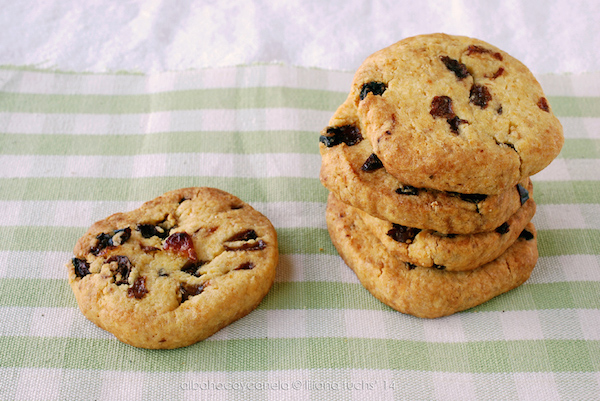 Photo by Liliana Fuchs/Flickr
Photo by Liliana Fuchs/Flickr
Zaletti are Venetian cornmeal raisin cookies that get their name from “zálo,” the Venetian dialect word for yellow. They are traditionally made without sugar and are often paired with dessert wine. Many American recipes, including this one by Mario Batali, include white sugar and eliminate grappa, which you have to assume has been done to appeal to an American palate. Do as they do in Rome (or Venice, in this case) and try the original recipe or adapt it to suit your needs.
5. Cuccidati — Sicily and Calabria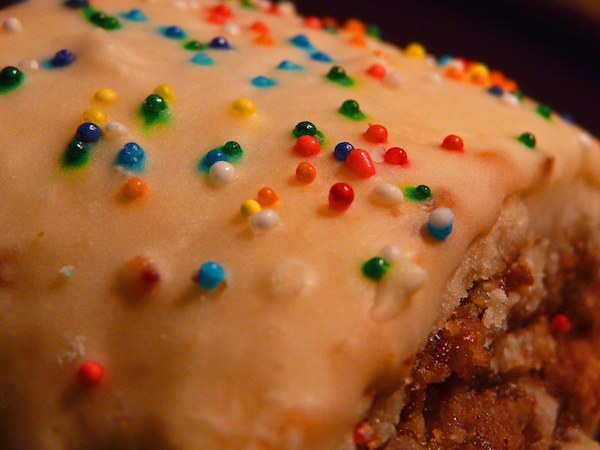 Photo by sea turtle/Flickr
Photo by sea turtle/Flickr
I Cuccidati are delightfully pretty Sicilian Christmas cookies that are made with a sweet fig and date filling, chopped hazelnuts and orange zest. Each town in Sicily has a variation on the recipe, and even a different name for it that suits their particular dialect (“vurciddatu” and “cucciddatu” are but a few alternate names for this cookie). Bakers may mold them into Christmas shapes, like wreaths or lambs, or keep things simply by cutting them into squares and embellishing them with colorful sprinkles. Calabrians will also recognize i cuccidati as one of their favorite Christmas cookies. Though similar, the Calabrian recipe generally omits dates and honey and adds chocolate chips and sometimes walnuts.
6. Occhio di Bue — Trentino-Alto Adige Photo: su-lin/Flickr
Photo: su-lin/Flickr
Baking dilettantes will love the breezy simplicity of Occhio di Bue, which means “bull’s eye” in Italian and consists of a minimal number of easy-to-find ingredients like egg yolks, apricot jam, cane sugar, flour and butter. These mini cookie sandwiches have become ubiquitous in Italy, but are most prevalent in areas up north like Trentino-Alto Adige, where Occhi di Bue recipes often include almonds and specific brands of flour from the region.
7. Ancient Roman Honey-Sesame Cookies — Rome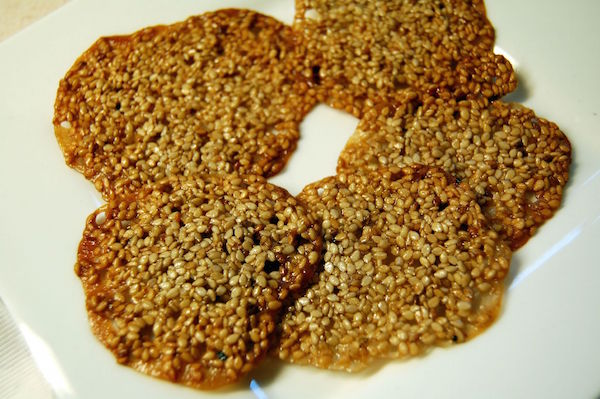 Photo by Dana McMahan/Flickr
Photo by Dana McMahan/Flickr
Bake a batch of Ancient Roman Honey-Sesame Cookies before the holidays and give guests the most delicious history lesson of their lives. These sweet and crunchy treats date back to the Egyptians and Greeks, but Romans get all the credit for realizing their potential as both a breakfast food and dessert. During the Second Punic War, the early Greeks and Phoenicians brought beekeeping to Rome. These cookies, which vary in shape and size depending on their baker’s whimsy (sometimes flat, but more often raised and circular), are just one of the happy results of Rome’s storied history with bees.
8. Ricciarelli — Siena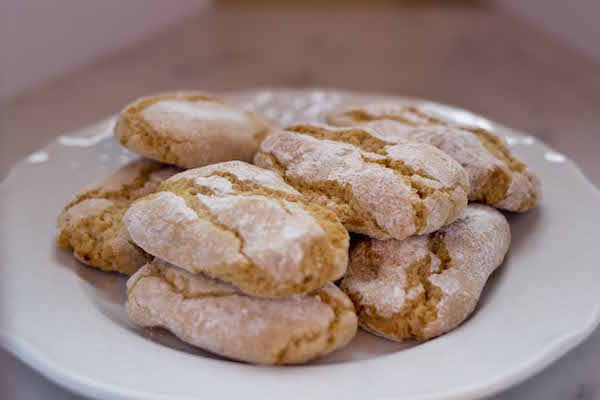 Photo by Wei-Duan Woo/Flickr
Photo by Wei-Duan Woo/Flickr
Ricciarelli, a soft macaroon cookie made with sugar, honey, almonds and egg whites, is traditionally served at Christmas time and paired with a dessert wine like Moscadello di Montalcino. These cookies originated in 14th century Siena, an area rich in almonds, and make for a particularly ornate and seasonal addition to your dessert table, thanks to a generous dusting of powdered sugar. More often than not, they include grated orange zest, but search and ye shall find modern versions of the recipe by chefs like Jamie Oliver, who adds chocolate to his Ricciarelli cookies.
9. Tarallucci Abruzzesi — Abruzzo Photo: Daniele Tenisci
Photo: Daniele Tenisci
Abruzzo is a magical region sandwiched between the Apennine Mountains and Adriatic Sea. Its proud residents make the most of every natural ingredient they grow, including the main four you’ll need to whip up Tarallucci Abruzzesi: wine, olive oil, flour and grape jam. Dust each half-moon cookie with powdered sugar and you have the perfect winter treat. You’ll find myriad deviations on the cookie in other regions (Calabria’s Bocconotti is quite common), but it’s the wholesome simplicity of Abruzzo’s Tarallucci that sets it apart.
10. Baci di Dama — Tortona, Piedmont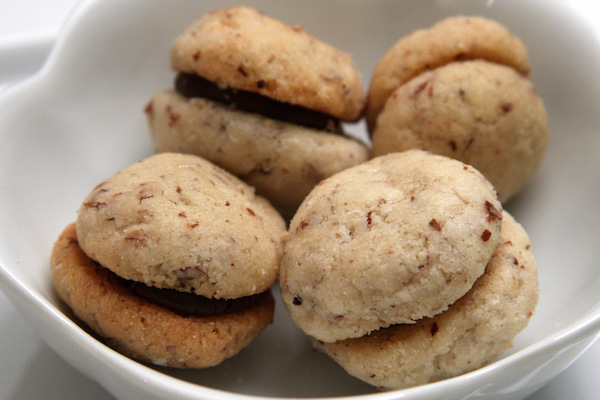 Photo: Larry/Flickr
Photo: Larry/Flickr
The only thing better than the fact that Baci di Dama means “lady’s kisses” in Italian is the fact that this cookie’s inside spread consists of the most heavenly of trifectas: hazelnuts, dark chocolate, and milk chocolate. Legend has it a pastry chef from the House of Savoy answered the request of Prince Vittorio Emanuele II in 1852 to create a brand new cookie — and these were born using just four ingredients: almonds, chocolate, sugar, and butter. The genius (and amorous) shape of these cookies, no doubt, sealed the deal for the prince.